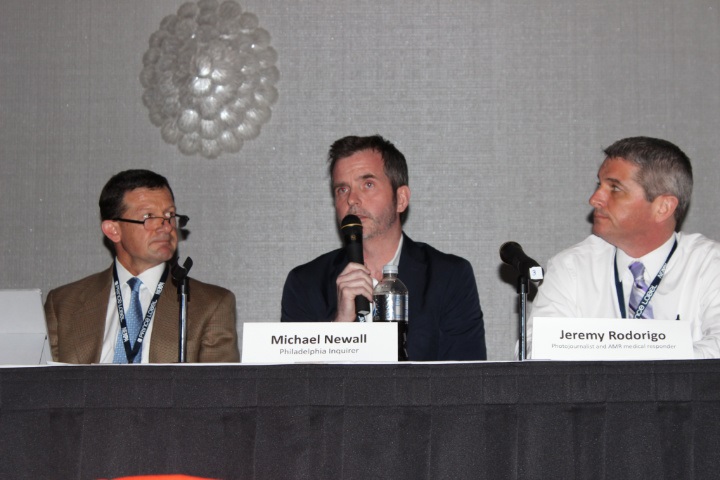
— Michael Newall, Columnist, Philadelphia Inquirer
Report or help? When, how
to help in an on-scene crisis
By Rebekah Patton
Bulletin Correspondent
Crises across the country and across the globe remain too present in today’s news coverage. Whether the story is about school gun violence or other mass-casualty incidents, forest fires, or hurricanes, the crisis reporter has a heightened chance of covering a story in a high-risk and unpredictable setting.
Knowing what to do and how to do it might be unclear when a dangerous situation arises, and when the immediacy of covering the story is challenged by the immediacy of saving a life. The role of an on-scene journalist can often be torn between being a working reporter and a compassionate civilian.
In such situations, there is a question of what involvement by on-scene journalists is most useful, and what help might actually be counterproductive.
Patrick Lee Plaisance of Penn State University, a former journalist; Michael Newall, a columnist with the Philadelphia Inquirer; and Jeremy Rodorigo, an executive and responder at American Medical Response in Waterbury, Conn., shared their thoughts during an emotional and timely discussion on when and how to act safely and professionally in such circumstances.
More than 30 people attended the session Friday, Feb. 23, at the New England Newspaper and Press Association’s winter convention at the Renaissance Boston Waterfront Hotel.
‘If it becomes a crime scene before your eyes, there is an inherent duty to step away from the camera and help out. Who would otherwise be vulnerable to harm if you were to not act? That is when you need to help.’
— Patrick Lee Plaisance, Professor, College of Communications, Penn State University
Plaisance, a professor at the College of Communications at Penn State University, initiated the discussion by discussing how and when journalists should intervene in a time of imminent danger.
He said it is best to intervene when the threat is imminent, and when you can help others avoid that threat.
“If it becomes a crime scene before your eyes, there is an inherent duty to step away from the camera and help out,” Plaisance said. “Who would otherwise be vulnerable to harm if you were to not act? That is when you need to help.”
“The journalist is also a human being,” Plaisance said. “Help out if you can.”
But Plaisance said that sometimes the best form of helping is recording the scene. Sometimes, the best intervention is telling the story.
One of his examples: During one of Martin Luther King Jr.’s nonviolent demonstrations in the early 1960s, sheriff’s deputies were throwing children to the ground. An on-scene photographer swung his camera onto his back on impulse and then became involved in shielding the children from harm, Plaisance said.
Plaisance said King witnessed the event and said to the photographer: “The world doesn’t know this happened, because you didn’t photograph it. I’m not being cold-blooded about it, but it is so much more important for you to take a picture of us getting beaten up than for you to be another person joining in the fray.”
Plaisance said: “Understand that the photographing and recording may be the most effective way of intervening at all. You need to realize what kind of aid would be most valuable in the situation and also for the future.”
He reminded the audience that the role of the journalist is not to act as a first responder; journalists should not intervene when they might endanger a life, including their own.
Credibility is also important when covering a story, Plaisance said. Adhering to being an impartial observer is a critical component in journalistic credibility, he said.
Newall covers the opioid epidemic in Philadelphia. Newall said between his experience with losing a brother to a heroin overdose and his firsthand experience of witnessing the impact that the opioid epidemic has caused in Philadelphia, he was compelled to become certified in administration of Narcan, the heroin antidote.
“The difference between life and death for someone in Philadelphia could be a stranger with Narcan,” Newall said.
Newall said he has successfully administered Narcan twice in Philadelphia.
His goal as a columnist is to break down the stigma of opioid addiction and overdose.
Rodorigo, a trainer of emergency medical technicians, concluded the session with a tutorial on the Stop the Bleed campaign, which involves bleeding control kits that are planned to be used in stadiums and heavily populated areas.
“There is a need for people to learn how to stop bleeding,” Rodorigo said.
The kits Rodorigo presented included emergency supplies with visual and written directions. The kits are intended to be used by trained staff at the sites, and by laymen who can open a kit and help respond to an emergency. Tourniquets, gloves, shears to cut off clothing, and gauze saturated with a hemostatic “quick-clot” were a few of the supplies.
Rodorigo said the average response time for his ambulance is seven minutes and 50 seconds for a call about severe medical emergency, such as a heart attack, stroke, or mass-casualty incident. Preparing for the worst with the emergency kits could save countless lives, he said.
John Voket, associate editor of The Newtown (Conn.) Bee and the newly elected NENPA president, moderated the session.
He said, “’Keep writing, keep shooting, don’t get involved’ is all old-age thinking.”
The session concluded with a question from an audience member: “What do you say to a victim when you are trying to help them?”
Rodorigo said: “Tell them you are trying to help them, and you are here with them.”
Even if the victim is unconscious, it is always best to talk to the victim in a calm tone, and explain what you are doing and how you are helping them, he said.
The audience listened in silence.
